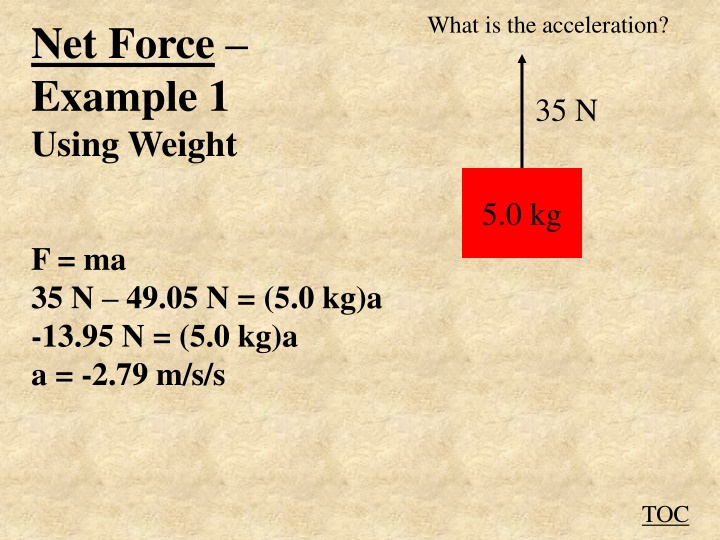
Physics Calculations: Acceleration, Force, and Weight Examples
Explore examples of calculating acceleration, net force, and weight in physics problems. Understand how to determine forces acting on objects of various weights and accelerations. Practice solving equations using mass, acceleration, and force components to analyze motion and forces in different scenarios.
Download Presentation

Please find below an Image/Link to download the presentation.
The content on the website is provided AS IS for your information and personal use only. It may not be sold, licensed, or shared on other websites without obtaining consent from the author. If you encounter any issues during the download, it is possible that the publisher has removed the file from their server.
You are allowed to download the files provided on this website for personal or commercial use, subject to the condition that they are used lawfully. All files are the property of their respective owners.
The content on the website is provided AS IS for your information and personal use only. It may not be sold, licensed, or shared on other websites without obtaining consent from the author.
E N D
Presentation Transcript
What is the acceleration? Net Force Example 1 Using Weight 35 N 5.0 kg F = ma 35 N 49.05 N = (5.0 kg)a -13.95 N = (5.0 kg)a a = -2.79 m/s/s TOC
What is the force? Net Force Example 2 Using Weight F = ? F = ma F 78.48 N = (8.0 kg)(+3.5 m/s/s) F = 106.48 N 8.0 kg (Accelerating upwards at 3.5 m/s/s) TOC
Whiteboards: Using Weight 1 | 2 | 3 | 4 | 5 TOC
Find the acceleration: F = ma, weight = (8.0 kg)(9.81 N/kg) = 78.48 N down Making up + <100. N - 78.48> = (8.0kg)a 21.52 N = (8.0kg)a a = 2.69 m/s/s 100. N 8.00 kg W +2.69 m/s/s
Find the acceleration: F = ma, wt = (15.0 kg)(9.81 N/kg) = 147.15 N down <120. N 147.15 N> = (15.0kg)a -27.15 N = (15.0kg)a a = -1.81 m/s/s It accelerates down 120. N 15.0 kg W -1.81 m/s/s
Find the force: F = ma, wt = (16 kg)(9.81 N/kg) = 156.96 N down <F 156.96 N> = (16.0 kg)(+1.5 m/s/s) F 156.96 N = 24 N F = 180.96 N 180 N F 16 kg a = 1.5 m/s/s (upward) W +180 N
Find the force: F = ma, wt = 1177.2 N downward <F 1177.2 N> = (120. kg)(-4.50 m/s/s) F 1177.2 N = -540 N F = 637.2 N 637 N F 120. kg a = -4.50 m/s/s (DOWNWARD) W +637 N
This box is going downwards at 22.0 m/s and is stopped in a distance of 1.85 m. What must be the upwards force acting on it to stop it? F First, suvat: s = -1.85 m, u = -22.0 m/s, v = 0, a = ? use v2 = u2 + 2as, a = +130.81 m/s/s 120. kg F = ma, wt = 1177.2 N downward <F 1177.2 N> = (120. kg)(+130.81 m/s/s) F 1177.2 N = 15697 N F = 16874.5 16,900 N W +16,900 N
If this box is initially at rest, what is its displacement in 5.00 seconds? 14.0 N 2.10 kg W -39.3 m
A falling 52.0 kg rock climber hits the end of the rope going 13.5 m/s, and is stopped in a distance of 4.20 m. What was the average force exerted to stop them? F F = ma, a = +21.696 m/s/s (from kinematics) wt = 510.12 N downward <F 510.12 N> = (52.0 kg)(+21.696 m/s/s) F = 1638.3 N 52.0 kg W +1640 N
A 65.0 kg dumbwaiter is going up at 5.80 m/s and is brought to rest in a distance of 1.90 m What is the tension in the cable supporting it as it is stopping? F F = ma, a = -8.853 m/s/s (from kinematics) wt = 637.65 downward <F 637.65 N> = (65.0 kg)(-8.853 m/s/s) F = 62.23 N 65.0 kg W +62.2 N
Find the force: F = ma, wt = 1176 N downward <F 1177.2 N> = (120. kg)(-4.50 m/s/s) F 1177.2 N = -540 N F = 637.2 N F 120. kg Relationship between tension, weight and acceleration Accelerating up = more than weight (demo, elevators) Accelerating down = less than weight (demo, elevators, acceleration vs velocity) Climbing ropes a = -4.50 m/s/s (DOWNWARD) W
Find the mass: F = ma, wt = m(9.81 m/s/s) downward <13.6 m(9.81 m/s/s)> = m(-1.12 m/s/s) 13.6 N = m(9.81 m/s/s) - m(1.12 m/s/s) 13.6 N = m(9.81 m/s/s-1.12 m/s/s) 13.6 N = m(8.69 m/s/s) m = 1.565017261 kg 1.57 kg 13.6 N m a = 1.12 m/s/s (downward) W 1.57 kg
